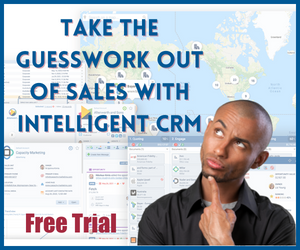Importance of CRM and Measuring Sales Effectiveness in Calls
No matter the discipline, you want to be effective. If what you’re doing isn’t effective, or moving you closer to your ultimate goal, there’s absolutely no reason to continue doing it. The struggle for salespeople becomes measuring sales effectiveness. It’s not as easy as counting calls or totaling revenue. It’s important to break down the process and analyze your performance at each step. John Golden interviews Anthony Stears on how to measure sales effectiveness with assistance from a CRM software.
This expert sales interview explores aspects of measuring sales effectiveness, such as:
- How to make calls that actually count
- Using a point system to divide the selling process
- The importance of using a process
- How CRM can help you be successful
Don’t count your calls. Make calls that count.
There should be value in every call, and you should consistently be moving people forward through your sales cycle. Most people measure three main things: the number of calls they make, the number of appointments that are set from these calls, and the number of deals that are closed. While these are all good things to measure, the logic used is that if you made 50 calls yesterday and set two appointments, making 100 calls today will lead to four meetings. This doesn’t always work. Closing deals don’t always correlate to how many calls that are made. Instead, it’s the quality of the call that moves people through the sales cycle. Therefore, measuring sales effectiveness is not as easy as counting the number of calls you make.
A Point in the Right Direction
To ensure that you make quality calls, Stears recommends developing a system and assigning a point to each part of the system. “Assign each thing in the sales cycle a point value. This helps you do things in order and keeps you from skipping to the end too quickly. Plus, you have a plan and know where you’re going next.” Stears explains how to score your first ten points in the expert sales interview, describing how to get from initial contact, all the way through closing a sale.
Process Driven Effectiveness
Some salespeople have resisted the idea of following a process and being process driven. But, the buyers have a process, and it’s important to align your selling process with how consumers buy things. If you’re not in line with them about how they make purchases, it will be difficult to close the sale. Additionally, having a system means that you know what is coming next. You can plant the seeds of the next step for the potential buyer. It’s not a surprise when you approach them, and they are prepared because they’ve already been thinking about it.
Using CRM to Track the Process
To keep track of your process, it’s crucial to use a quality CRM system to manage your pipeline. Pipeliner CRM is one such software that can do everything Stears recommends. One feature is that when you look at the archive of potential sales in your pipeline, you can see precisely at what stage you lost the deal. You can also look at each rep on the sales team individually, and differentiate weak spots that need to be improved for each person. Additionally, you can create a step by step activity. This prevents you from moving onto the next stage in the sales cycle without completing the previous one. This would be an excellent opportunity to assign points to each step so that you can replicate Stears’ point process.
For a top of the line CRM system, check out Pipeliner CRM. If you’re interested in learning more from Anthony Stears, watch his first expert sales interview, Getting to Know the Telephone Assassin.
About our Host:
John is the Amazon bestselling author of Winning the Battle for Sales: Lessons on Closing Every Deal from the World’s Greatest Military Victories and Social Upheaval: How to Win at Social Selling. A globally acknowledged Sales & Marketing thought leader, speaker, and strategist. He is CSMO at Pipeliner CRM. In his spare time, John is an avid Martial Artist.








Comments